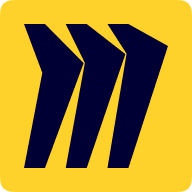The "5A" Slow Cognition Model

What I learned from the Once Upon A Whiteboard project
In 2021, I developed several knowledge frameworks in order to test some meta-theories and meta-frameworks.
In order to test these frameworks, I also worked on the following independent research projects with diverse methods such as Ecological Observation, Participatory Research, Thematic Analysis, and Theory-based Reflection.
- A project about Self-installation Activity and Customer Service design.
- A project about Digital Whiteboard Platforms.
- A project about an Online Adult Development program.
- A project about Diagramming and Knowledge Building.
I used the lean approach to manage these projects. Since my primary goal is testing theoretical frameworks, I focused on collecting data and capturing insights, not writing final reports.
This week I reflected on these projects and considered them a journey of "Slow Cognition".
What did I find from this journey? See the diagram below.
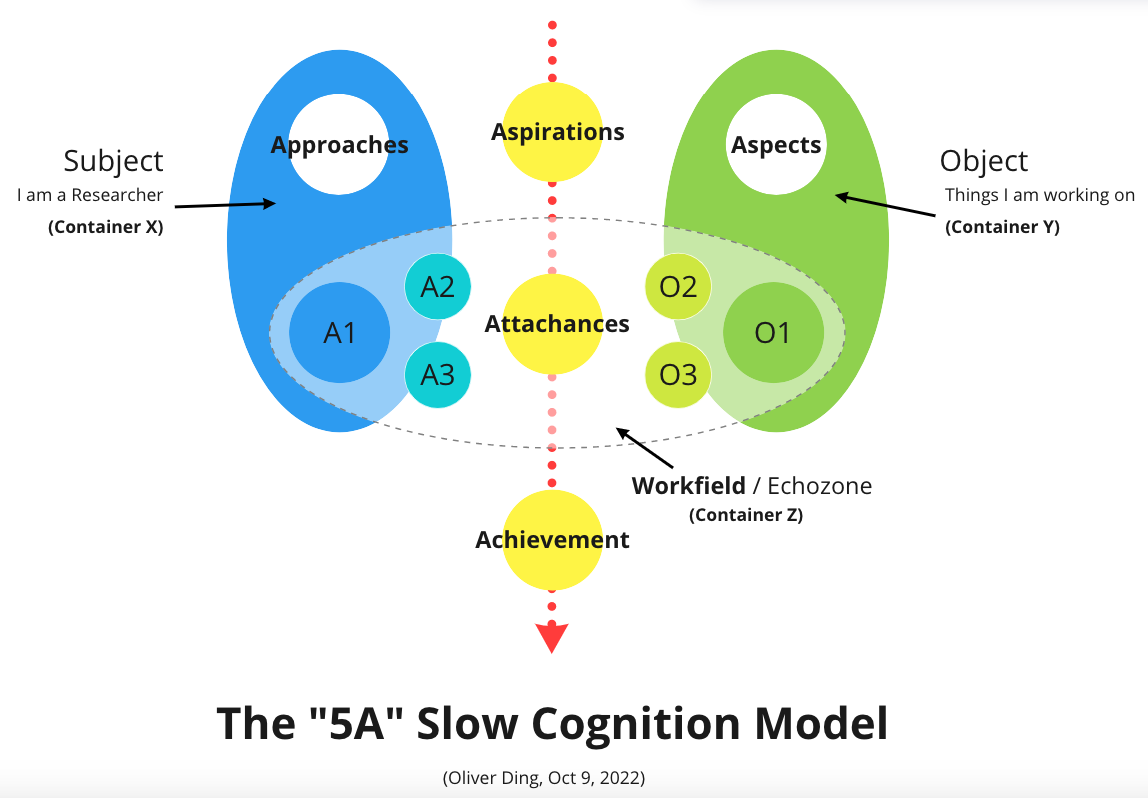
I use the following five keywords to summarize my creative pattern behind the journey of Slow Cognition:
- Aspirations
- Aspects
- Approaches
- Attachances
- Achievement
This article aims to use the Once Upon A Whiteboard project as an example to discuss this model.
Contents
- The Basic Model
- Aspirations
- Aspects
- Approaches
- Attachances
- Achievement
1. The Basic Model
The above diagram is based on the WXMY meta-diagram which uses three containers for diagramming.

The concept of Container is the core of the Ecological Practice approach. By adjusting the quality and quantity of the Container, we can create advanced frameworks for discussing complex phenomena. The quality of the Container can be potential and actual, and the quantity of the Container can be one or two. If we develop a new framework with one potential container and two actual containers, the outcome is the above diagram.
I named the potential container (Container Z) Echozone which refers to a creative space containing echoes between Container X and Container Y.
If we apply the WXMY meta-diagram to my independent research projects, then we have the following containers:
- Subject (Container X): I am a researcher
- Object (Container Y): Things I am working on
- Workfield (Contaienr Z): the Echozone of Research project
Inspired by the term "Workshop", I coined a new term called "Workfield".
What's the difference between Workfield and Workshop? While Workshop has a clear temporary boundary, Workfield rejects the notion of a temporary boundary.
The notion of Workfield is more about the "interactive space between the subject (a person...) and the object (a thing)". It's an object-centered spatial boundary, in other words, it is a Container.

The above diagram is the basic model of the Ecological Practice Approach. It doesn't offer us more details about the container. The "Subject - Workfield - Object" model describes a special type of container.
The "Subject - Workfield - Object" model is also different from Activity Theory's basic model: mediating actions. See the diagram below:

The "S - X - O" model emphasizes the mediating instruments between Subject and Object. Both technical tools and psychological tools are actual things.
However, the "Subject - Workfield - Object" model uses three containers to understand the Subject-Object relationship. While Container X and Container Y are actual, Container Z can be potential.
This is the major difference between the Ecological Practice approach and Activity Theory. The Ecological Practice Approach claims that both potential and actual are ecological realities.
These two models are not against each other. They can work together since they emphasize different aspects of the Subject-Object relationship. In an article about Mapping Thematic Journey, I applied the "S-X-O" model to discuss my creative journey of engaging with Activity Theory.
This article will focus on the "Subject - Workfield - Object" model and use the Once Upon A Whiteboard as an example to discuss my journey of independent research projects.
2. Aspirations
Why did I start the Once Upon A Whiteboard project?
On March 31, 2021, I edited a book (draft) titled Platform for Development: The Ecology of Adult Development in the 21st Century. The book refers to an intersection between digital platforms and adult development. I have been paying attention to these two domains for over ten years. As a participant in digital platforms, I am both a user, a curator and a maker. As a participant in adult development, I have founded several non-profit online communities which aim to support the life development of university students and young professionals.
The book also offers a brand new concept called Supportance is developed for discussing the relationship between a person and social environments. This concept is inspired by ecological psychology and developmental psychology, especially the concept of Affordance. I also developed a new concept called Platformba which refers to a Platform-based social interactive space. The diagram below represents the basic model of the book.

Inspired by Ecological Psychology, Activity Theory, and other social practice theories, I started developing the Ecological Practice Approach in 2019. I wrote a book (draft) each year and developed a theoretical concept for the approach.
- From Sept 2018 to March 2019, I wrote a book titled Curativity: The Ecological Approach to Curatorial Practice in order to reflect on one of my life themes: Curation. The Ecological Practice Approach was born from the process of writing Curativity.
- In May 2020, I wrote another book titled After Affordance: The Ecological Approach to Human Action. I proposed several new theoretical ideas for expanding ecological psychology to the modern digital environment.
- In March 2021, I wrote Platform for Development: The Ecology of Adult Development in the 21st Century and introduced the concept of Supportance.
The concept of Supportance means the Ecological Practice approach has transformed from a curated toolkit to an original theoretical framework. This is a major milestone of the approach. You can find more details in The Development of Ecological Practice Approach.
In April 2022, I changed my focus from theoretical development to empirical research in order to test the Ecological Practice approach and its sub-frameworks.
I selected Virtual Whiteboard and related platform-based practice for my first empirical research project.
Why?
In fact, my primary interest is studying Virtual Space Affordance. The term Affordance comes from James Gibson's Ecological Psychology. It means "what environment offers the animal, what it provides or furnishes, either for good or ill." I consider Virtual Whiteboards as a new kind of environment, so I coined the term Virtual Space Affordance for studying Virtual Whiteboards.
The Once Upon A Whiteboard was born in April 2022. It is an independent project and adopts a lean study approach. It has a clear goal for testing my theoretical approaches and frameworks. However, the plan is not clear. I worked on both matching frameworks and platforms and researched real work cases one by one.
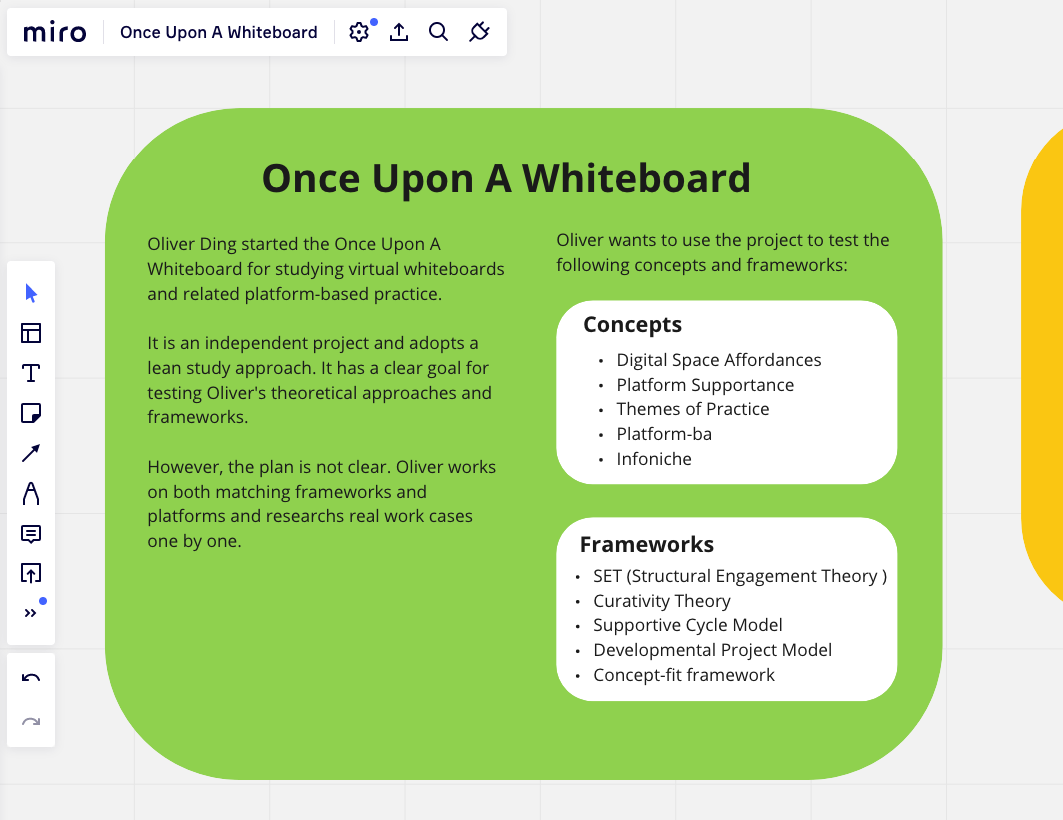
In April 2021, my friends hosted a two-month program for online discussions about a magazine: The Whole Earth Catalog (W.E.C.). The host used Milanote, Wechat, and various Video meeting platforms for the program.
According to Wikipedia, "The Whole Earth Catalog (WEC) was an American counterculture magazine and product catalog published by Stewart Brand several times a year between 1968 and 1972, and occasionally thereafter, until 1998."
The digital workshop is called BACK TO W.E.C. which is a paid event. My friends made several copies of the W.E.C. and sent each participant one copy and asked them to post "pieces" of W.E.C. on boards in Milanote. Each week, they hosted a real-time meeting on Whereby.
My friend hosted the workshop on Milanote (a creative whiteboard) with other tools such as Whereby (a real-time meeting platform) and WeChat (the largest social app in China).
I used a method called Participant Observation to study this workshop. I joined the program as a researcher and collected various types of data such as all Milanote boards under the program, notifications from Milanote, Wechat group messages, and weekly meeting videos.
I also discussed the case with my friends. I learned a lot from the process. This was the first case study of the Once Upon A Whiteboard project.
3. Aspects
The primary Object of the Once Upon A Whiteboard project is Virtual Whiteboards. However, each sub-project has its own primary Object. For example, Milanote is the primary object of the BACK TO W.E.C. program.
In fact, I considered the BACK TO W.E.C. program as a whole as my primary object. This notion refers to platform-based social practice.

The first lesson I learned from real field experience of empirical research is the multiple aspects of objects.
Both Virtual Whiteboards and related social practices have multiple aspects of objects.
Virtual Whiteboards are a type of computer software and web applications that simulate whiteboards. As an emerging digital environment, virtual whiteboards offer users unique Digital Space Affordances.
Traditional web applications such as Blogs and Wiki only allow users to type texts and add hyperlinks, they don't allow users to use the screen as free space. On the contrary, Virtual Whiteboards allow users to use the screen as a large space for drawing and other actions.
On June 11, 2021, I did a real test of Digital Space Affordances on Medium (a blog website) and Miro (a virtual whiteboard platform).
- Medium: Career API Canvas (This Draft is for Testing “Digital Space Affordances”)
- Miro: Curativity Theory for Personal Innovation
Miro’s board is better for supporting my Diagramming as Thinking work than Medium’s editor.
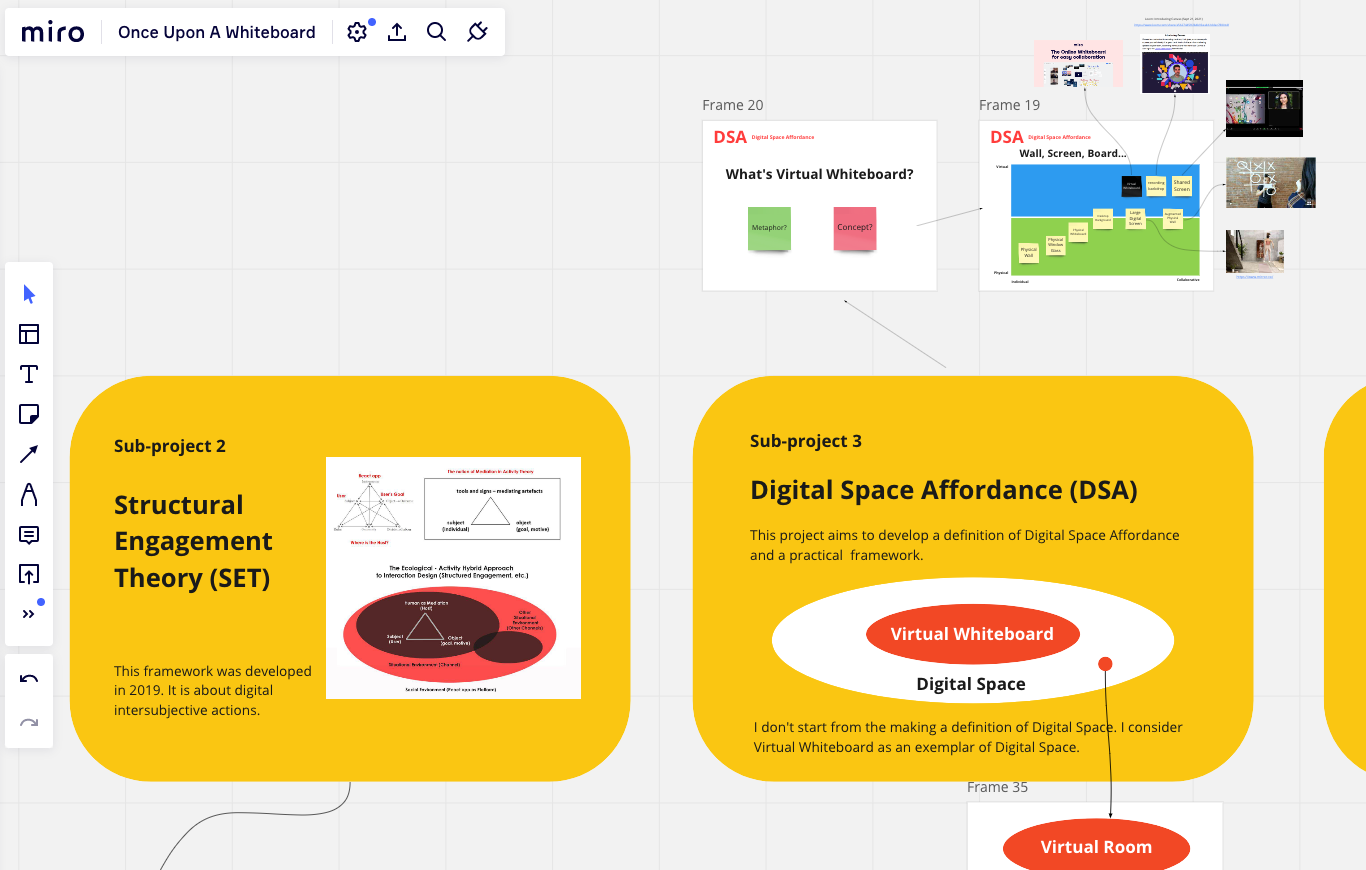
Though my original intention is testing my theoretical concepts and frameworks, I changed my mind and embraced multiple aspects of objects. I used the Sub-project method to capture some aspects I want to explore.
I created the following 10 sub-projects for the Once Upon A Whiteboard project:
- Sub-project 1: Milanote (BACK TO W.E.C.)
- Sub-project 2: Structural Engagement Theory (SET)
- Sub-project 3: Digital Space Affordance (DSA)
- Sub-project 4: Boardle (Social Diagramming)
- Sub-project 5: Platform Supportance
- Sub-project 6: Prezi v.s. Miro
- Sub-project 7: The Knowing-for-us Practice
- Sub-project 8: The Kanban Practice
- Sub-project 9: The Miro Classroom
- Sub-project 10: Platform Curativity
What kind of aspects of virtual whiteboards do these sub-projects refer to? See the diagram below. I listed two groups of aspects of virtual whiteboards and related platform-based social practices.
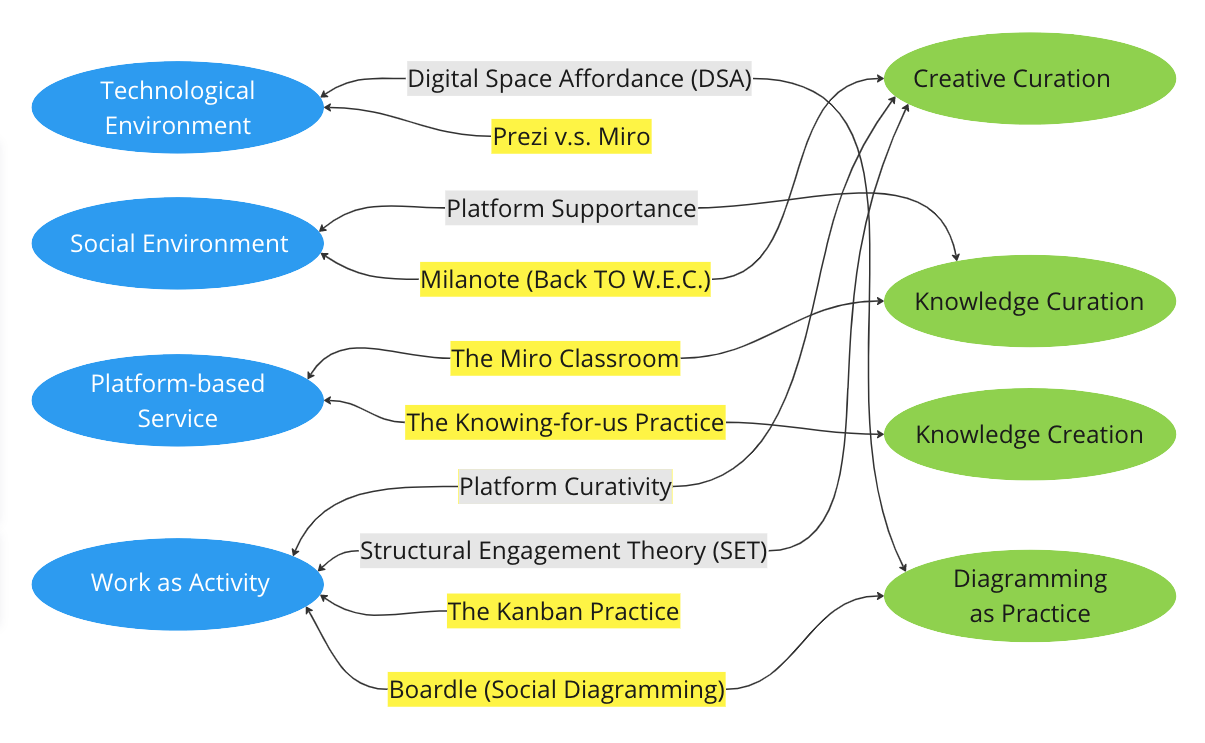
The Blue group is about the theme of "environment" and the theme of "activity". I pay attention to the environmental aspect of virtual whiteboards. I also considered "using virtual whiteboards" as a work-type activity.
The Green group refers to the spatial aspect of virtual whiteboards and related social aspects, especially knowledge-related user experience.
Sub-projects are divided into two groups too: the Grey group refers to theoretical concepts or frameworks while the Yellow group refers to real examples. Some sub-projects refer to several aspects of virtual whiteboards and related social practices.
Let's use the "Milanote (BACK TO W.E.C.) - Creative Curation" connection as an example for the present discussion.
The term "Creative Curation" is pretty interesting because there is a paradox behind the term: Curativity against Creativity. Creators tend to think and act without any frame. However, Curators tend to give a frame to think and act in order to make a meaningful whole.
Virtual Whiteboards make a balance between Curativity and Creativity. For example, Milanote is understood as "the Evernote for Creatives". It also uses "Get organized. Stay creative." as its slogan. See the screenshot below.
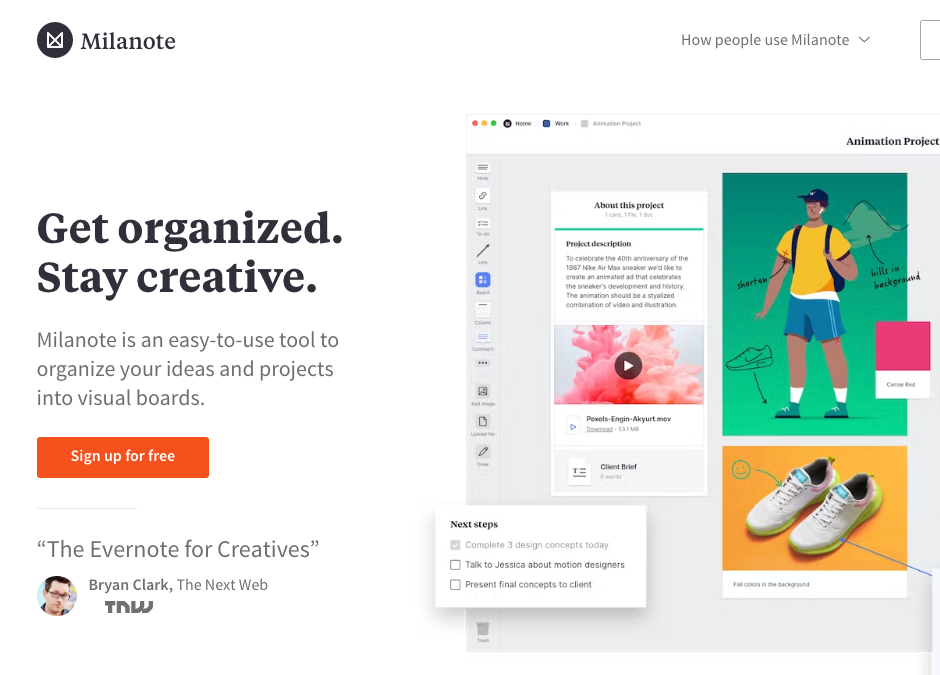
I also found the theme of "Creative Curation" from the BACK TO W.E.C. program which can be understood as an example of platform-based social practices. The program was designed as a two-month program. After one month, the program host discussed the progress with me and told me that they struggled with the style of program curation: open v.s. control.
This is interesting because the theme of "Creative Curation" appears in both the technological environment and the social environment.
4. Approaches
As a researcher, the BACK TO W.E.C. program is a real Workfield to me. In two months, I found several aspects of the program.
I didn't only see things about Milanote, but also other platforms such as Whereby and Workflowly!
Each week, the program hosted a real-time meeting on Whereby which is a video meeting platform. They told me that they tried many video meeting platforms in the past two years. Each time, they also tried a new method of using Whereby for their meetings. For example, different ways of breakouts.
Each time, the host invited four members to share what they read about the Whole Earth Catalog. This is an amazing section for me because each member has his/her own style of sharing ideas. I also noticed that each member used different tools for sharing their thoughts and stories. One member made a Workflowly page and used it in the meeting. This was the first time I had seen a person uses a Workflowly page in a meeting.
My original goal in joining the BACK TO W.E.C. program was to test the Supportive Cycle model which is a sub-framework of the Platform-for-Development framework. However, I was surprised to see diverse events in the Workfield.
Eventually, I adopted other frameworks which belong to different theoretical approaches to the BACK TO W.E.C. program and the Once Upon A Whiteboard project in general.
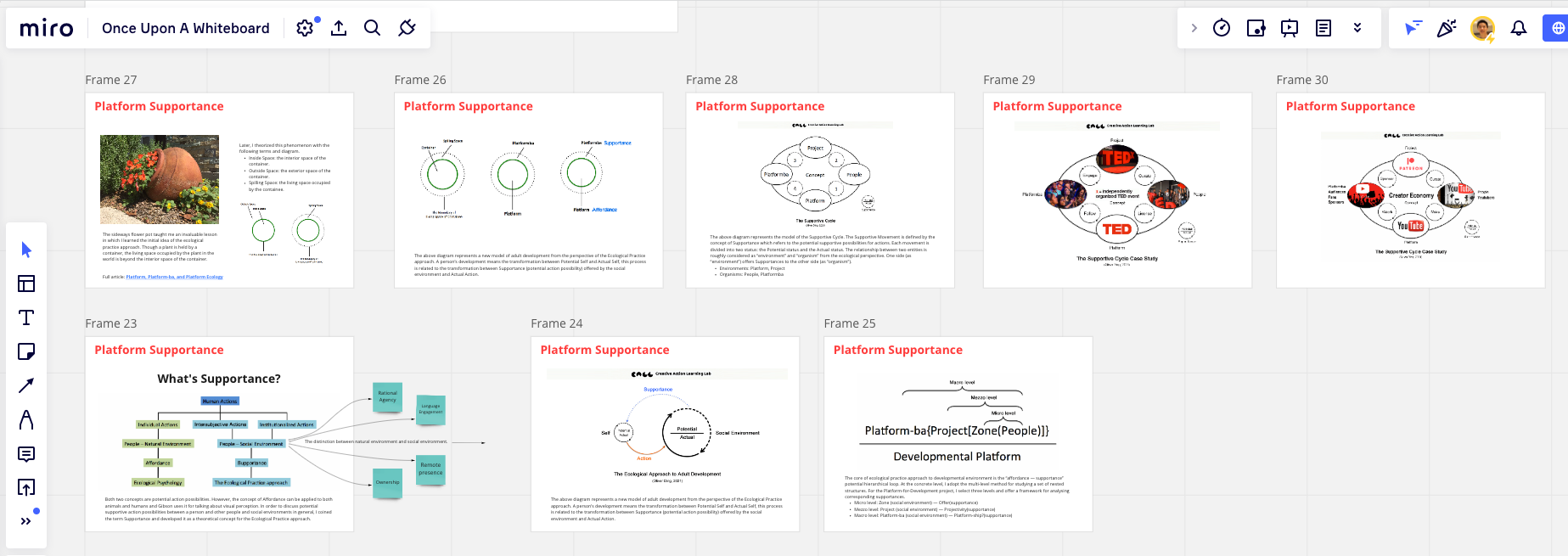
The above screenshot is about the concept of "Platform Supportance" which is part of the Platform-for-Development framework.
While the concept of "Platform Supportance" is really useful for understanding "Milanote (BACK TO W.E.C.)", I also found Curativity Theory was perfect for the BACK TO W.E.C. program.
The core idea of Curativity Theory is very simple:
In order to effectively curate pieces into a meaningful whole, we need Container as part to contain pieces and shape them.
The theory built a brand new ontology called “Whole, Piece and Part” and adopted James Gibson’s “Affordance”, George Lakoff’s “Container” and Donald Schön’s “Reflection” as epistemological tools.

The above diagram is a framework of Curativity Theory. You can find more details in Curativity Theory: The Ecological Approach to General Curation Practice and Curativity Theory: Table of Contents and Related Articles.
Both the Whole Earth Catalog and the BACK TO W.E.C. program are great cases for applying Curativity Theory.
The Whole Earth Catalog was a unique magazine that curated items as tools. It was published between 1968 and 1972. Steve Jobs once mentioned it in his June 2005 Standford University commencement speech.
When I was young, there was an amazing publication called The Whole Earth Catalog, which was one of the bibles of my generation ... It was sort of like Google in paperback form, 35 years before Google came along. It was idealistic and overflowing with neat tools and great notions.
What did Steve Jobs actually see?
See the picture below.
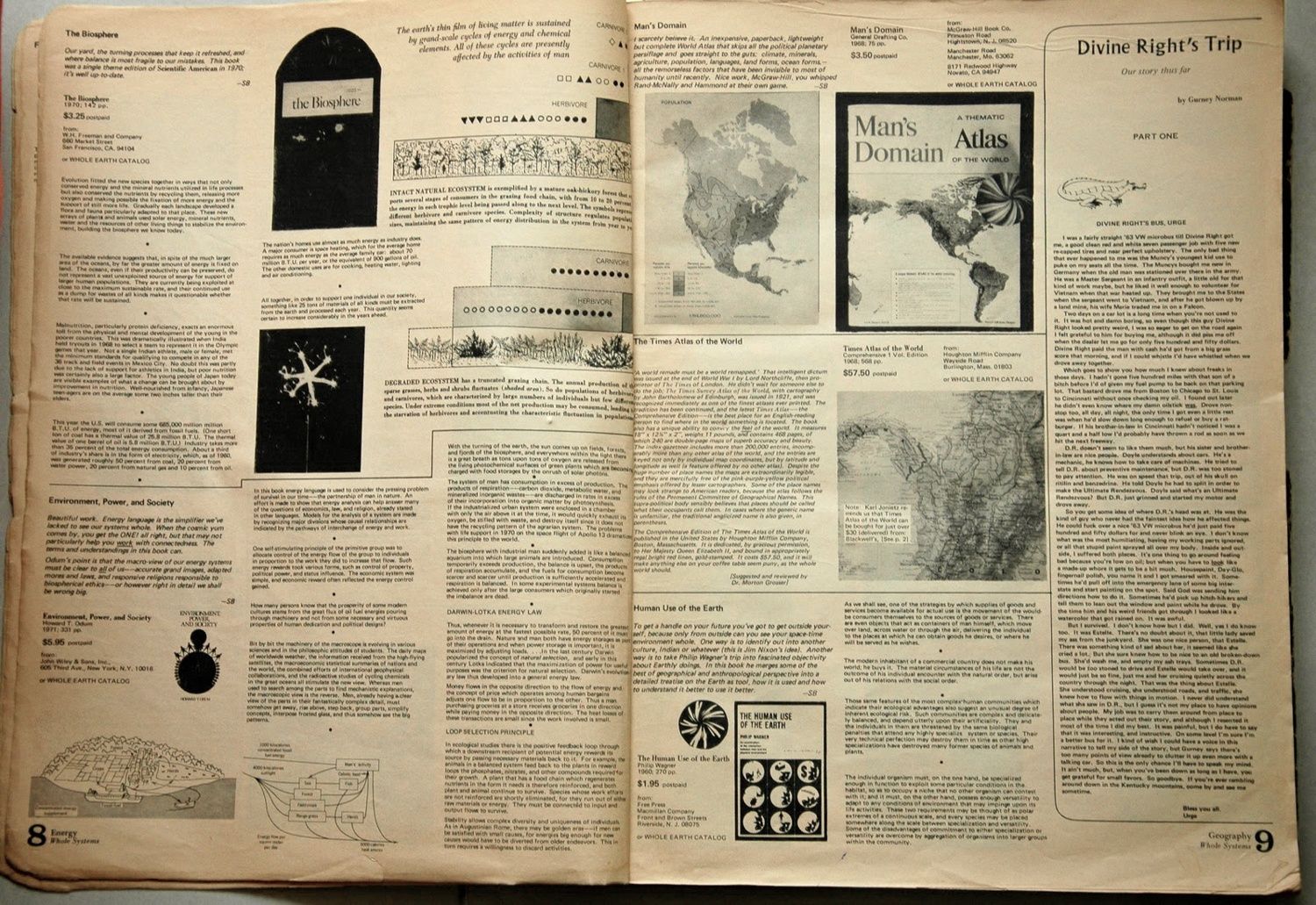
Yes! This is a typical Curation: turning pieces into a meaningful whole!
The picture below is another page of the Whole Earth Catalog. You can find more stories about it on Wikipedia.
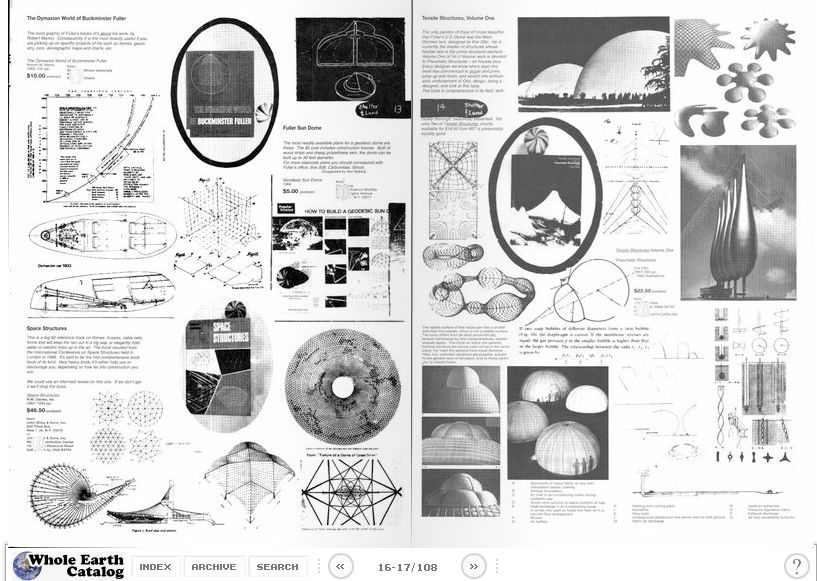
What about the BACK TO W.E.C. program?
This is a fantastic story.
- They turned the Whole Earth Catalog into pieces and sent copies of the catalog to their members.
- They built one board on Milanote and created several sub-boards under the board. Each sub-board refers to a theme of the catalog.
- They asked members to post notes on sub-boards and created new boards for particular new themes.
The two-month program is a meaningful whole.
Their Milanote board is a meaningful whole.
Moreover, they made a print version of the board and turned the digital boards into one real magazine after the program.
The new magazine is a meaningful whole.
I wrote a case study by using the following five core concepts of Curativity Theory and sent it to the host:
- Curatorial Affordances
- Containers
- Themes of Practice
- Curatorial Configuration
- Curatorial Crafting
These concepts are introduced in Chapter 3: Ecological Curativity Theory of my book. You can find more details in Curativity Theory: Table of Contents and Related Articles.
I also found a 2017 framework that is really useful for understanding virtual whiteboards and other digital platforms. The framework is called SET and it was originally named the Ecological—Activity Hybrid Approach. It was developed from 2017 to 2020 when I worked on several projects which refer to a new type of social action platform. See the screenshot below.
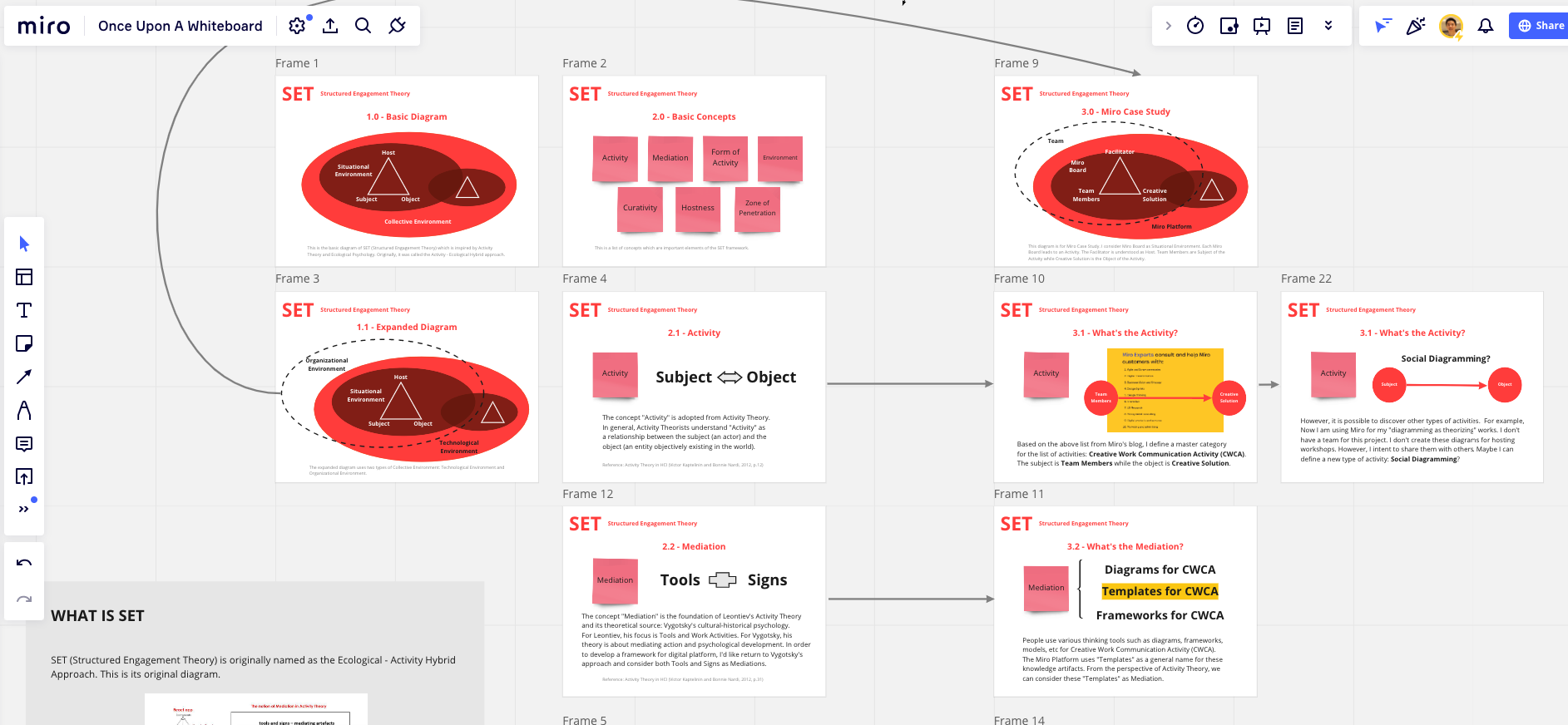
Traditionally, Activity Theory uses "Subject - Mediation - Object" as a basic unit of analysis. The Activity system model expands the basic unit of analysis to "Subject - Mediation - Object - Rules - Community - Divisions of Labour". However, I found there is a gap between Activity Theory and Intersubjective Social Design.
For example, I worked on a one-to-one video talk product from 2017 to 2018. Later, I worked on other projects which adopt Structured Engagement as a design pattern. These projects share the following aspects:
- Host: a special type of actor who hosts the whole activity.
- Structured Engagement: the activity is human-to-human interactions with a special structured process.
- Environment: the environment is also part of the design of the activity.
I started learning Activity Theory, Ecological Psychology, and other theories around 2015. Since then, I have often used some theoretical concepts such as Mediation from Activity Theory, Affordance from Ecological Psychology, etc for our product development discussions.
I realized the Activity System model, which is a popular theoretical framework of Activity theory, is not an ideal framework for theorizing above intersubjective social actions. In 2019, I developed the Ecological — Activity Hybrid Approach by adopting ideas from Activity Theory and Ecological Psychology. In 2020, I renamed the approach SET which stands for Structured Engagement Theory.
In 2021, I applied the SET framework to study digital whiteboard platforms such as Miro and Milanote. I designed an expanded diagram for my research. This expanded version has three types of environments:
- Situational Environment: For example, a Miro board and related events.
- Organizational Environment: For example, the team behind the Miro board.
- Technological Environment: For example, Miro and other related digital platforms.
Later, I also used it to study Platform-based Services such as an adult development program.
You can find more detail in The SET Framework [Hybrid Approach].
5. Attachances
The term Attachances means the meanings and values of two types of Acts: the Detaching Act and the Attaching Act. It is a core concept of the Ecological Practice Approach. See the diagram below.

The "Aspects - Approaches" Fit brings me many Attachances. As discussed above, I had to detach my mind from one aspect and attach my mind to another aspect. I had to detach my mind from an approach and attach my mind to another aspect.
Moreover, I had to detach my mind from one particular "Aspect - Approach" fit to attach my mind to another "Aspect - Approach" fit.
Many Significant Insights emerged from the flow of Attaching and Detaching.
One thing I have to mention is the notion of "Network Enterprise" which was developed by the creativity researcher Howard Gruber. In his study of Charles Darwin, Howard Gruber (1974) showed that even a great scientist embraces by-productive thinking in his creative work process.
I used "Network Enterprise" to manage my creative work and built a network of creative ideas. I also used the notion of "Product/By-product" to manage the development of the network of creative ideas. You can find more details in Life-to-be-Owned: The Achievement Chain.
Let's see an example of "Taking Attachances" from the Once Upon A Whiteboard project.
As mentioned above, I planned to use the BACK TO W.E.C. program to test the Supportive Cycle model. The diagram below is my initial model of the program.
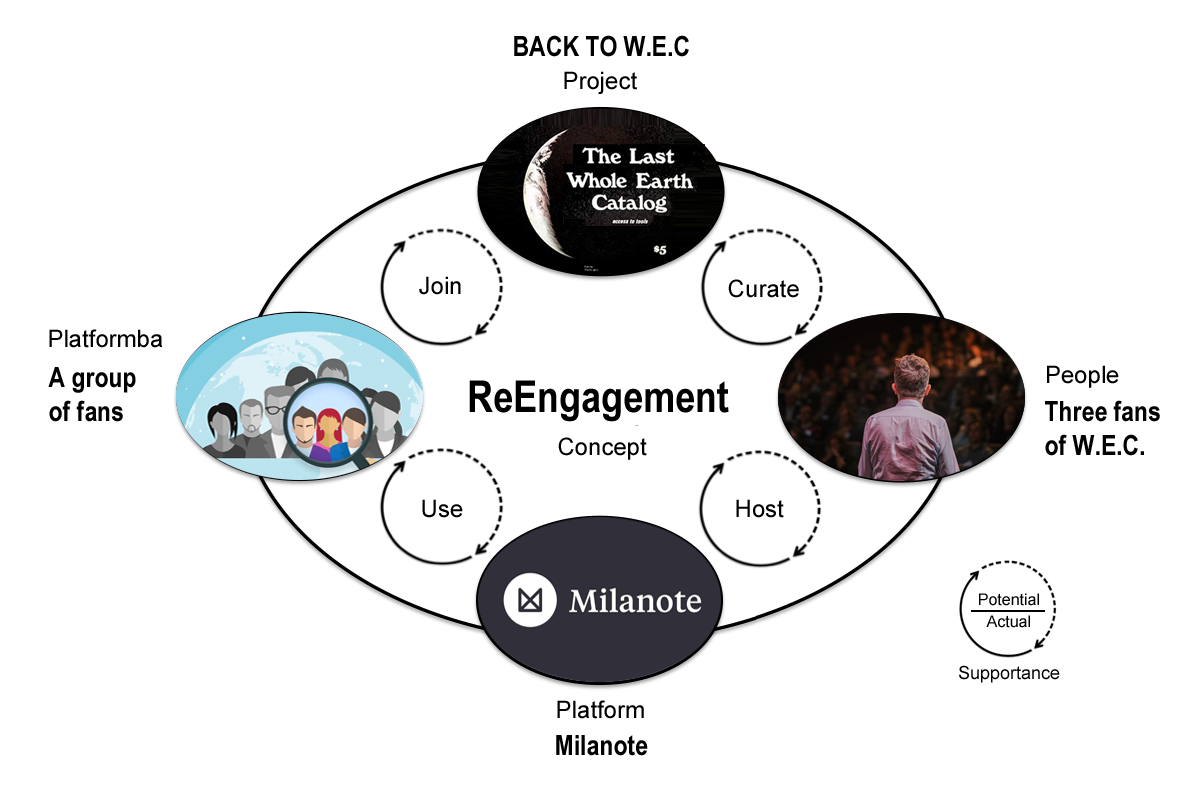
The above diagram represents the model of the Supportive Cycle. The four types of entities are Platform, People, Project, and Platformba. The model also considers four types of Supportive Movements.
The Supportive Movement is defined by the concept of Supportance which refers to the potential supportive possibilities for actions. Each movement is divided into two states: the Potential status and the Actual status. The relationship between two entities is roughly considered as “environment” and “organism” from the ecological perspective. One side (as the “environment”) offers Supportances to the other side (as the “organism”).
- Environments: Platform, Project
- Organisms: People, Platformba
There is a term called Concept at the center of the above diagram. This term is adopted from Project-oriented Activity Theory which considers an activity as a process of formation of a brand new concept. From the perspective of the theory, the term “project” refers to such a process. The Platform-for-Development framework is inspired by Project-oriented Activity Theory, it would be great to incorporate Concept into the Supportive Cycle since a Concept can be considered as the Curator of the whole activity. By adopting a Concept, the four supportive movements become a meaningful whole process.
Initially, I thought the Concept should be Re-Engagement because the program re-engaged with The Whole Earth Catalog.
However, I found a new concept after joining the program. I realized that there is a structural tension between the Open tendency and the Control tendency in the program. Thus, I named it "Creative Curation".
As a participant in the program, I also often detached from a Researcher and attached to an Actor. The Attachancs of switching between two roles also inspired many new insights. For example, I created two sub-boards on the board of the program.
- One board is about Affordance because I found the catalog's items can be used to discuss the concept of Affordance which is about the human-material interaction.
- The other board is about Curativity because I thought the W.E.C. and the program are good examples of Curativity Theory.
I used the Curativity board to shared ideas about Magazine, TED, W.E.C., and note-taking. I shared a piece of my book Curativity Theory on the board and had a wonderful discussion about Knowledge Curation on the board.
The discussion inspired me to write a new book (draft) titled The ECHO Way in April 2021. It was a 312-page draft.
Later, I used my experience to make a new model. See the diagram below.
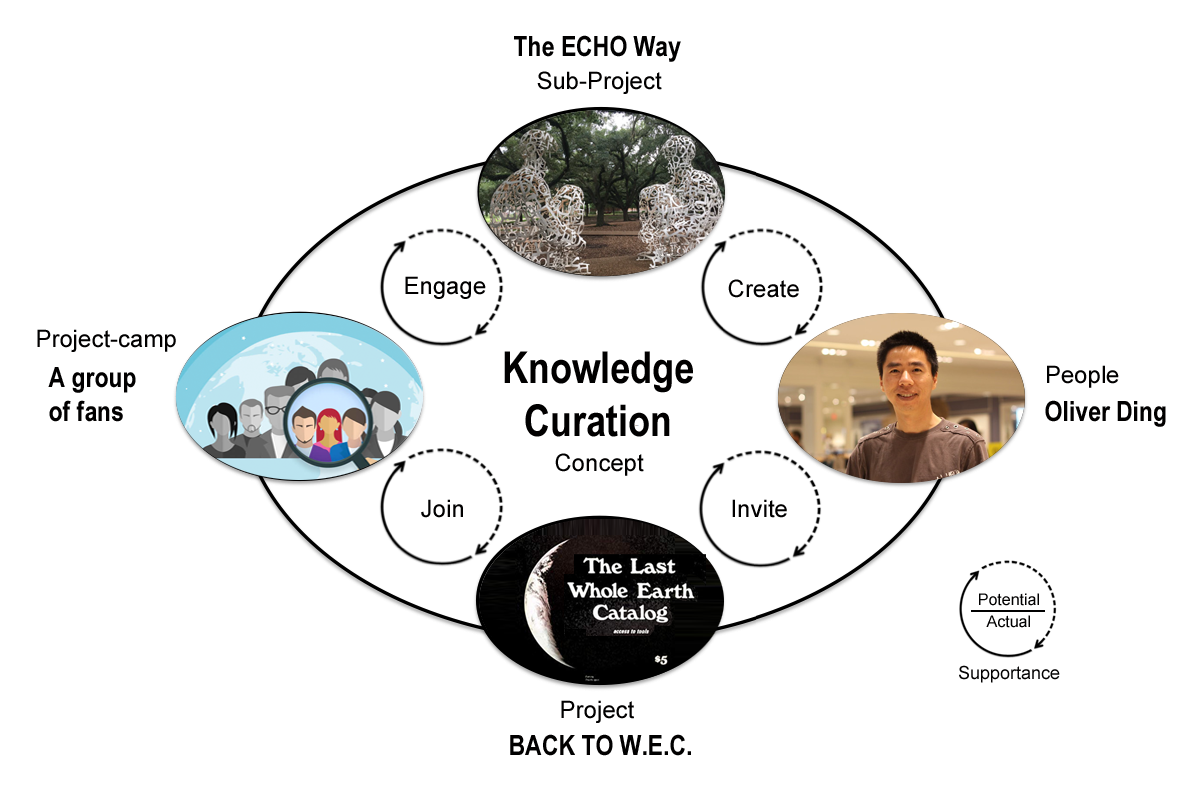
In the above diagram, I used a new term called "Sub-project" to describe The ECHO Way project because it was born from the BACK TO W.E.C. project.
In fact, I found some members also started their own "Sub-projects" within the BACK TO W.E.C. program.
What a great Creative Curation! You can find the BACK TO W.E.C. board here.
Based on the "Aspects - Approaches" fit, I discovered some Significant Insights which could lead to the “Hypothesis — Data” test. For example, the notion of "Sub-projects" was born from a "Hypothesis - Data" test.
The Hypothesis was the basic unit of Platform (Project) which is the foundation of the Platform-for-Development framework. I also used the Infoniche framework to expand the basic unit of Platform (Project). See the diagram below.

The Data was what I found in the BACK TO W.E.C. program. I used the data to test the Supportive Cycle model and found a new unit of analysis: Sub-project. Also, it inspired me to modify the Infoniche framework and made a new diagram called the Infoniche Model.
You can find the whole process of the reflection in the above board.
6. Achievement
As mentioned above, I used the notion of "Product/By-product" to manage the outcome of my creative work. You can find more details in Life-to-be-Owned: The Achievement Chain.

The Achievement Chain is inspired by the following theoretical resources:
- The Activity System Model(Yrjö Engeström,1987): Subject — Outcome.
- The evolving systems approach to the study of creative work (Howard E. Gruber, 1974,1989): By-product.
- The constructive—developmental approach (Robert Kegan, 1982, 2009): The Evolving Self.
I didn't work on one project, but on a network of projects. For a particular project, a significant insight is a by-product. However, the by-product could be a great resource for another project. Moreover, a sub-project of a project could be detached as an independent project.
The Once Upon A White project doesn't have any formal outcome, but it produced several by-products which led to great achievements for me.

I shared my reflection about the HERO U framework on the board about Curativity in the BACK TO W.E.C. program. Eventually, I wrote a new book called THE ECHO WAY in April. It is a 312-page draft. Later, It led to The ECHO Way (v2.0).
It inspired me to share the SET framework. In the Workfield, I saw the real value of the SET framework, this insight changed my mind on perceiving the value of the framework.
I also defined a new practice called Platform-based Service.
A significant impact of the project is that I decided to return to the D as Diagramming project. After making the board about the Infoniche model, I used it as an example to test my 2018 model about Diagram. See the picture below.

In order to review the historical development of the diagram of the Supportance model, I wrote some ideas on the board. In 2018, I wrote a 108-page thesis titled Diagram Explained. I developed a framework for understanding multiple layers of diagrams and wrote a list of topics about diagramming.
Moreover, the Once Upon A Whiteboard project inspired me to re-perceive the value of Diagram Explained and my activity around diagramming.
On August 10, 2021, I decided to detach my attention from the Once Upon A Whiteboard project and attached my attention to the D as Diagramming project.

In Dec 2021, I closed the D as Diagramming project (phase 1) and edited two possible books. You can find more details in the following links:
- Diagram Blending: Building Diagram Networks (Introduction)
- Diagram Blending: Building Diagram Networks (Table of Contents)
- Diagramming as Practice (Book, version 1.0)
There is a simple pattern behind my creative journey.
Every independent research project is a long-term Workfield for me. I live within the Workfield and perceive new information in the new environment. Then, I will discover Aspects of the Workfield.
Then, I will apply some related frameworks that match some aspects.
Based on the "Aspects - Approaches" fit, I will discover some Significant Insights which could lead to the “Hypothesis — Data” test.
Moreover, I use the "network of enterprise" method to manage my projects. I don't work on one project, but a net of projects.
Finally, I also use the notion of "Product/By-product" which is part of "Network of Enterprise" method to manage outcomes and the achievement chain.

